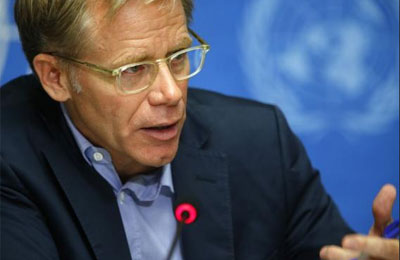
Dr Aylward ... long-term psychosocial needs of survivors vital.
Health top focus at WHO disaster risk forum
SENDAI, Japan, March 15, 2015
Protecting people's health is at the centre of a framework for global action that opened today (March 14) in Sendai, Japan to reduce the risks of disasters.
The Third United Nations World Conference on Disaster Risk Reduction (WCDRR), running until March 18, is the most important event in emergency and disaster risk management since the Hyogo Framework for Action was agreed in Kobe 10 years ago.
An estimated 8000 participants are expected to attend, including 15 Heads of State, more than 80 ministers and around 10 high-level United Nations chief executives, including the United Nations Secretary General.
“In the 10 years since Hyogo, governments have increasingly recognized that healthy people are resilient people, and that resilient people recover much more quickly from emergencies and disasters," said Dr Bruce Aylward, assistant director general for Emergencies at the World Health Organization (WHO).
"Recent and ongoing disasters – from Typhoon Haiyan in the Philippines to the Ebola crisis in West Africa – highlight the centrality of human health to our collective goals in disaster risk reduction by all sectors."
WHO announced three major initiatives to support countries as they translate the goals of the new international framework – that is being negotiated at the 3rd World Conference on Disease of Risk Reduction – into action for health.
A new WHO policy framework has been designed to help national policymakers build capacities to effectively manage emergency risks and reduce their health consequences. Recognizing the importance of disease early warning systems to disaster risk reduction, WHO renewed its commitment to help all Member States achieve their core capacities to detect, assess, notify and respond to epidemics and other public health threats under the International Health Regulations (2005).
WHO has also released a new Comprehensive Safe Hospital Framework for reducing disaster damage to this critical aspect of a community's emergency and health infrastructure, which is one of the key targets under discussion in Sendai.
“The Safe Hospitals Initiative is about more than protecting buildings," said Dr Aylward. "It's about ensuring that health facilities are accessible and functional, at maximum capacity, immediately after a disaster strikes.”
Part of this initiative is the Hospital Safety Index – a tool that provides a rapid assessment of the essential safety and preparedness measures hospitals must take to remain operational in emergencies. In large-scale disasters, such as those caused by earthquakes or floods, some countries have lost 50 per cent of their hospital capacity, compromising their ability to respond to the emergency and to provide important health services such as immunization.
Recent disasters have shown again that such preventive measures can save lives and reduce health impact. No casualties were reported in the majority of affected areas when Typhoon Ruby hit the Philippines in December 2014, due in part to increased preparedness after Typhoon Haiyan destroyed more than 600 health facilities in 2013.
Governments and communities around the world are increasingly making hospitals safer in the face of disasters. As part of the Safe Hospitals Initiative, 79 countries have taken action over the past 20 years to make their hospitals safer in disasters, with more than 3500 facilities assessed.
“The increased attention to health in Sendai reflects the needs and lessons learned from the Great East Japan and Great Hanshin Awaji Earthquakes,” says Alex Ross, director of the WHO Kobe Centre in Japan.
“In particular, we need to focus on the long-term psychosocial needs of survivors, of vulnerable groups such as older people and people with disabilities, and the urban environment in order to build resilient health systems and communities.”
For 20 years, the WHO Kobe Centre has conducted operational research in these areas and disseminated and shared lessons across the world. – TradeArabia News Service







